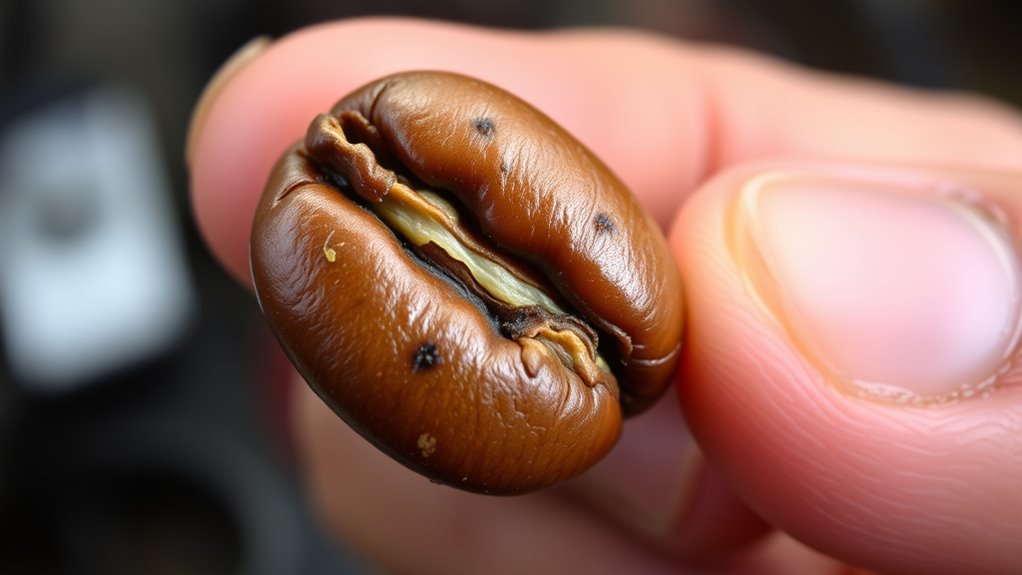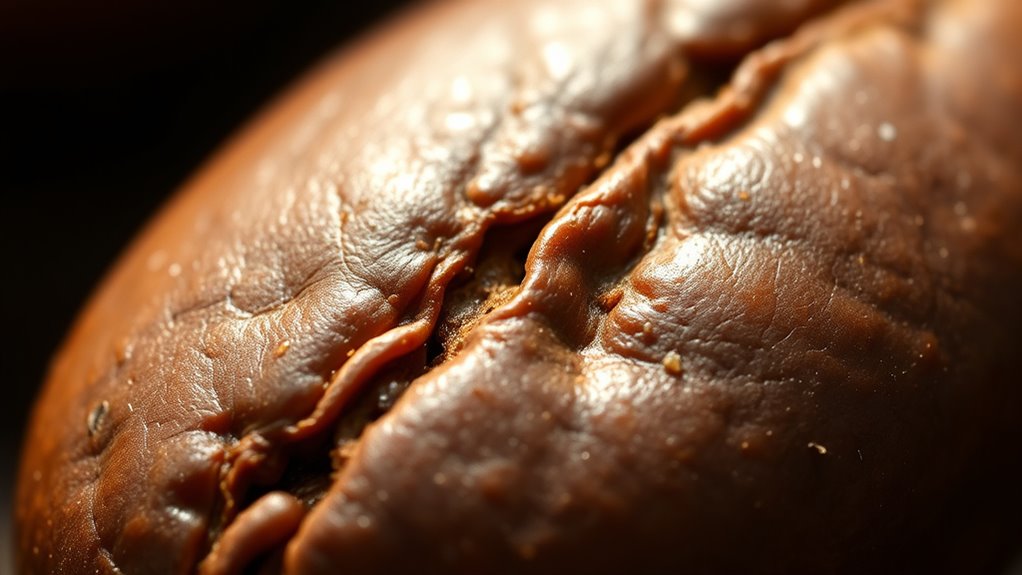The 300-gram defect count is a standard measurement that helps determine if coffee qualifies as specialty grade. It involves inspecting a 300-gram sample for defects like broken beans, black specks, or foreign materials. Maintaining this number low ensures the coffee meets quality standards, improves flavor, and meets industry regulations. If you want to understand how this standard influences coffee’s overall quality and classification, continue exploring the details.
Key Takeaways
- The 300-gram defect count measures the number of imperfections in a sample, ensuring it meets specialty coffee standards.
- A low defect count correlates with higher cupping scores and overall quality in specialty coffee.
- Strict defect thresholds are essential for qualifying coffee as “specialty grade,” emphasizing quality and appearance.
- Sorting practices, both manual and mechanical, help reduce defect counts and maintain compliance with standards.
- Monitoring defect counts allows producers and roasters to ensure consistency, flavor integrity, and marketability of their coffee.
What Is the 300-Gram Defect Count and How Is It Measured?

The 300-gram defect count measures the number of defects found in a specific weight of fabric, which is typically 300 grams. You’ll evaluate this by inspecting a sample of coffee beans and counting imperfections such as broken beans, black specks, or foreign material. Cupping scores help determine the overall quality, but the defect count sets the threshold for what’s acceptable. If the number of defects exceeds the defect thresholds, the sample doesn’t meet specialty standards. This count is vital because it directly influences the coffee’s grade. A low defect count indicates higher quality, aligning with stricter cupping scores. By carefully measuring defects within this weight, you ensure the coffee meets the rigorous standards required for specialty classification. Additionally, understanding the importance of color accuracy in the evaluation process can help in assessing the visual quality of the beans and ensuring consistency.
The Role of Sorting and Grading in Specialty Coffee Quality

After establishing how defect counts determine the baseline quality for specialty coffee, the focus shifts to how sorting and grading refine that quality further. Sorting techniques play a pivotal role in removing defective beans that could compromise flavor or appearance. By carefully sorting beans, you improve overall grading accuracy, ensuring only the best beans reach consumers. Manual sorting involves visual inspection, while mechanical sorting uses technology to detect defects more precisely. Proper grading not only assesses quality but also influences pricing and marketability. When you implement effective sorting and grading practices, you enhance the consistency and integrity of your coffee, aligning with industry standards. This process helps uphold the standards that define specialty coffee, ensuring that each batch meets the high expectations associated with the label.
Standards and Regulations: Defining “Specialty Grade” Coffee

What exactly sets apart “specialty grade” coffee from other types? It’s primarily defined by strict standards and regulations that ensure quality. These include specific grading standards, which evaluate defect counts, flavor, and overall appearance. Additionally, harvest practices play a critical role; beans must be carefully picked to avoid defects and ensure consistency. To qualify as specialty grade, coffee must meet or exceed set thresholds, such as minimal defect counts and excellent ripeness. Here are key points:
Specialty grade coffee meets strict standards for quality, flavor, and careful harvesting.
- Grading standards that control defect limits, including the 300-gram defect count.
- Strict harvest practices to ensure only ripe, healthy beans are selected.
- Regulations that require transparent documentation and consistent evaluation processes.
These factors collectively uphold the integrity of “specialty grade” coffee.
Impact of Defect Counts on Flavor and Overall Quality

Defect counts directly influence the flavor profile and overall quality of coffee, as even minor imperfections can alter how the beans taste and how enjoyable the cup is. High defect counts risk compromising flavor integrity, introducing off-flavors or unevenness that distract from the coffee’s true character. When defect levels remain low and within the 300-gram standard, you experience consistent quality in every cup, reinforcing your trust in the beans’ integrity. Excessive defects can create inconsistency, making it difficult to predict flavor outcomes. By maintaining strict defect counts, producers ensure that each batch preserves the desired flavor nuances and quality standards. Additionally, controlling defect counts supports quality assurance and helps uphold industry standards for specialty coffee. Ultimately, controlling defect counts supports a more reliable, enjoyable coffee experience, anchoring the distinction between specialty-grade excellence and lower-quality alternatives.
How Producers and Roasters Use the Defect Count to Ensure Excellence

Producers and roasters rely on the defect count to maintain consistent quality by carefully monitoring and managing the number of imperfections in each batch. This process is crucial for quality control and ensuring the coffee meets specialty standards. By tracking defect counts, you can identify patterns, address issues early, and prevent subpar batches. Additionally, implementing systematic inspection protocols helps ensure safety standards are met throughout production. This systematic approach helps you produce reliable, high-quality coffee, reinforcing your commitment to excellence and customer satisfaction.
Frequently Asked Questions
How Does the 300-Gram Defect Count Compare to Other Grading Standards Worldwide?
You might wonder how the 300-gram defect count compares to other grading standards worldwide. This method offers consistent grading by focusing on defect counts per 300 grams, aligning with international standards for quality assessment. It helps you guarantee grading consistency across different regions and suppliers, making it easier to evaluate coffee quality globally. Overall, it provides a reliable benchmark that supports uniformity in grading practices worldwide.
What Specific Defects Are Most Common in Specialty Coffee Samples?
Imagine opening a bag of coffee, only to spot bean blemishes and insect damage lurking within. These defects are the most common in specialty coffee samples, spoiling the smooth, vibrant flavors you seek. Bean blemishes mar the surface, while insect damage creates tiny holes and dark spots. You’ll find these imperfections can markedly impact quality, making careful sorting and inspection essential to maintain that high-standard cup you crave.
How Do Defect Counts Influence Consumer Perception and Purchasing Decisions?
Defect counts directly influence your quality perception and purchasing decisions. When you notice fewer defects, you’re more likely to view the coffee as higher quality, making you more inclined to buy it. Conversely, higher defect counts can lead you to doubt the coffee’s consistency and value. Ultimately, defect counts shape your confidence in the product, guiding your choices based on perceived quality and the assurance of a superior coffee experience.
Are There Technological Innovations That Help Detect Defects More Accurately?
You should know that AI detection and machine vision have revolutionized defect detection. These technologies enable you to identify flaws more accurately and quickly than traditional methods. By integrating AI detection, you can analyze fabrics with precision, reducing false positives and ensuring quality. Machine vision systems automatically inspect textiles, helping you maintain high standards and meet industry benchmarks efficiently. This innovation enhances your ability to deliver defect-free products, boosting customer trust.
How Does Climate Change Impact Defect Rates in Coffee Production?
Climate change affects defect rates in coffee production by increasing weather variability, which stresses plants and causes inconsistent bean quality. Imagine a farm experiencing unpredictable droughts and heavy rains—this climate instability reduces climate resilience, leading to higher defect counts. As weather becomes more unpredictable, you’ll notice more defects, making it harder to maintain quality standards and increasing the need for adaptive farming practices to combat these challenges.
Conclusion
Understanding the 300-gram defect count helps you appreciate the precision behind specialty coffee grading. Did you know that only about 10% of coffee beans worldwide meet this high standard? By paying attention to defect counts, you can enjoy a cup that’s consistently flavorful and high quality. Next time you sip your brew, remember the meticulous efforts behind maintaining those strict standards—it’s what makes your coffee truly exceptional.









